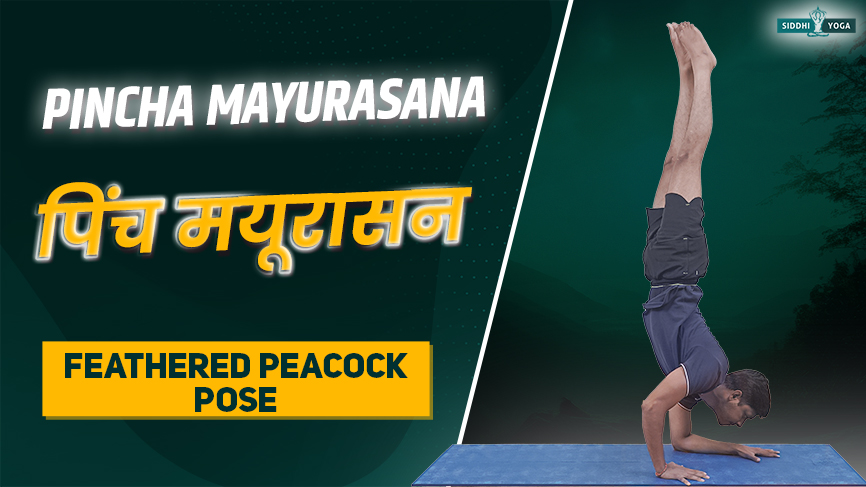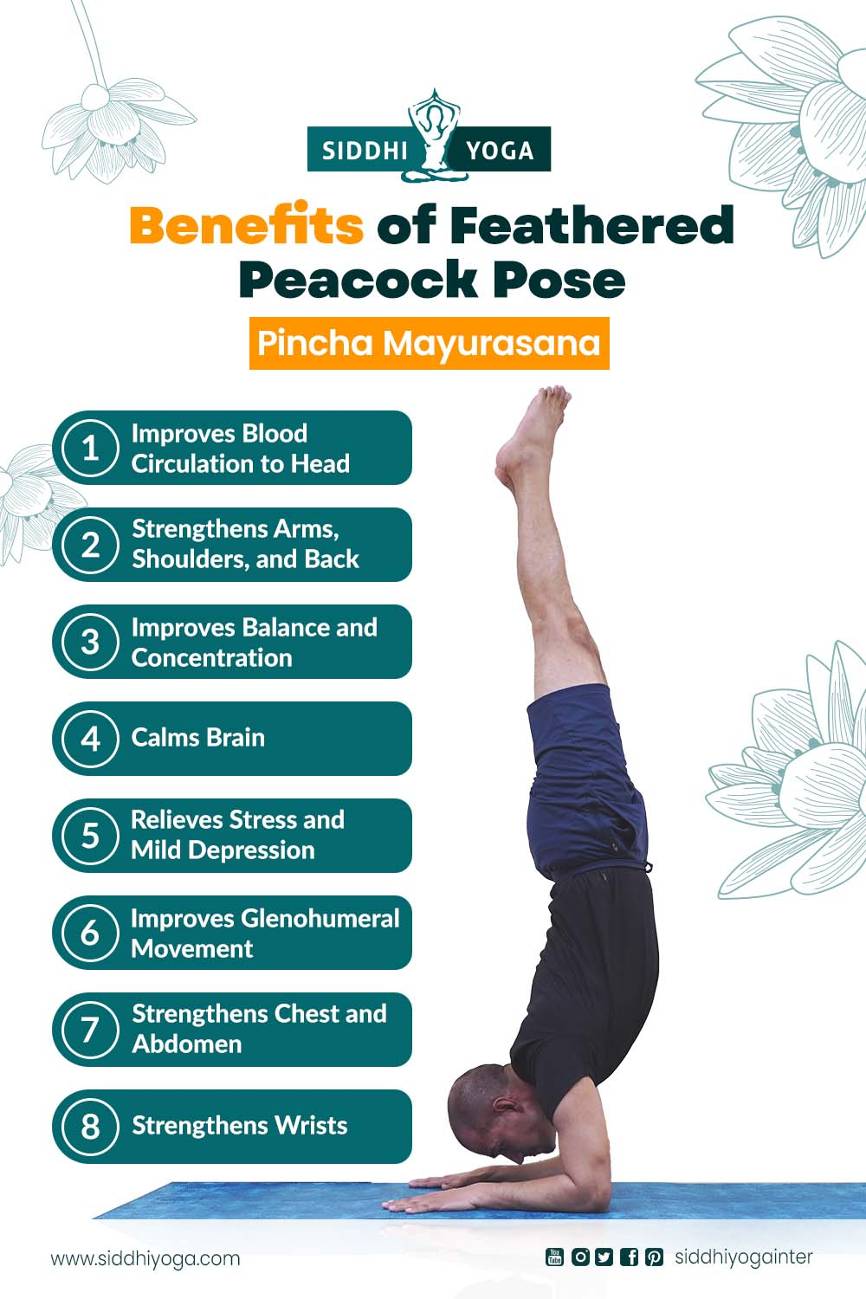
Mayur: Peacock
Asana: Pose
Pincha Mayurasana at a Glance
Pincha Mayurasana or the Peacock pose, also known as the feathered Peacock pose is challenging inversion, graceful, and represents strength and balance. Get through the dolphin pose base pose to get into this pose. This pose helps to stimulate the Ajna chakra and Crown chakra.
Benefits:
- It helps to strengthen your shoulders upper back, and forearms.
- This helps to enhance your core strength and strengthen your thighs.
- This helps to stretch your entire body and reduces stiffness and tension from your body.
- It helps to increase the blood flow to your brain.
- It increases your balance and helps you overcome your fear.
Who can do it?
Advanced and intermediate yoga practitioners can do this pose. Sportspersons and dancers can do this pose. People who want to improve their upper body strength can do this pose. People who want to enhance their mind-body balance and coordination can do this pose.
Who should not do it?
Beginners should avoid this pose. People with any injury to their arms, shoulders, back, and wrist should avoid doing it. Any recent surgery should avoid this pose. People with headaches or high blood pressure headaches avoid it. Women during pregnancy and menstrual cycle should void this pose.

How to Do Pincha Mayurasana?
Follow the Step-by-Step Procedure
This is a challenging posture so progress slowly with patience, as you need to develop balance and strength before getting into this pose.
- To start this forearm balance pose you can come to the Adho Mukha Svanasana or the Downward-Facing Dog Pose. Stretch your arms straight and take some deep breaths.
- Place your forearms on the ground, resting on your elbows, and should be aligned with your shoulders.
- Lift your head, walk your leg to your head, now your forearm and upper arms should be I 90 90-degree angle.
- Keep your shoulders firm your forearm grounded and your fingers spread.
- Slowly throw your right leg up and keep the leg straight and when you are comfortable, bring your left leg up too.
- Keep your legs straight to the sky and maintain balance on the forearms and palms.
- Gaze a little ahead and keep your core and thigh muscles engaged.
- Keep breathing and hold this pose for a few breaths at your comfort level.
- When you are ready to release, inhale and bring your one leg down and then the other and relax in the child pose.
What are the Benefits of Pincha Mayurasana?
- It helps to build strength and stability in the upper body and arms.
- It helps to open your shoulders and gives a good stretch.
- It reduces tension and stiffness in the neck and upper back.
- This pose helps to improve your balance and coordination.
- It improves the blood flow to your brain, which helps calm your brain.
- It helps to boost your energy and improves your self-confidence and willpower.
- It helps to reduce your fear of challenging situations in life.
- When you bend your elbows in and place them on the floor, it becomes much harder to flex your shoulder joints.
Health Conditions that Might Benefit from Pincha Mayurasana
- This yoga practice can reduce mild back pain and strengthen core muscles.
- The blood flow to your brain reduces stress and anxiety promotes better mental health and improves focus and concentration.
- This can help to relieve mild sciatica pain.
- This involves the abdominal muscles which helps the proper functioning of the digestive system.
Safety and Precautions
- For Any heart issues or headaches avoid this pose.
- Any injury or surgery avoid this pose.
- Warm-up and preparatory poses are important.
- Don’t do it after meals.
- Any discomfort or pain just comes out of the pose.
- Initially do it under the guidance of the yoga teacher.
Common Mistakes
- Not respecting your body and forcing it into the pose.
- Don’t allow your elbows to spread outward.
- Don’t round or overach your back.
- Avoid holding your breath.
- Entering the pose and releasing should be smooth.
Tips for Pincha Mayurasana
- Strengthen your core and improve your balance before doing this pose.
- Gaze in front of you at a steady point.
- Follow the proper alignment procedures.
- Kick the lifted leg with the foot flexed as your bottom leg hops up.
- Keep breathing continuously.
- Keep your legs engaged.
- Use wall support initially.
Physical Alignment Principles for Pincha Mayurasana
- Forearms grounded; fingers spread wide and palms flat.
- Elbows in line with the hands and shoulder width and forearms parallel.
- Broaden your shoulder blades.
- your head stays off the floor.
- Gaze comfortably in between the arms.
- Your navel tucked to your spine and core is engaged.
- Your glutes are engaged.
- Your legs are straight extended and active.
- Toes pointed and foot flexed.
- Squeeze your inner shins together.
- Draw your front ribs inward.
- Keep your quads engaged while rotating inward.
Pincha Mayurasana and Breath
Walk this pose with the coordination of the breath. Inhale deeply and walk your leg to your head. Exhale and balance your forearms, engage your core, and kick your legs up straight. Keep breathing to maintain balance and stability. While you exit, exhale and bring your legs to the ground slowly, being aware of the movement of the body. Keep your breath steady and avoid holding your breath.
Pincha Mayurasana and Variations
- Dolphin pose.
- Pincha Mayurasana with one foot on the wall.
- Padma Mayurasana is a challenging pose.
- Half feathered peacock pose.
- Scorpion poses.
The Bottom Line
Pincha Mayurasana or Feathered Peacock Pose is an amazing yoga pose that provides many benefits – physical, mental, and emotional. The key to getting into this pose is by building strength and flexibility over time. Be patient and consistent with your practice and soon enough you will be able to do this.
Unlock the door to a fulfilling career in yoga instruction with our accredited yoga teacher training courses. Choose from our foundational 200-Hrs Yoga Teacher Training Course, advanced 300-Hrs Yoga Teacher Training Course, or the all-encompassing 500-Hrs Yoga Teacher Training Course – all certified by Yoga Alliance, USA. Immerse yourself in the world of yoga philosophy, anatomy, teaching methodologies, and more. Embrace this opportunity to become a certified yoga instructor and inspire others on their path to wellness. Enroll now and embark on a transformative journey!